|
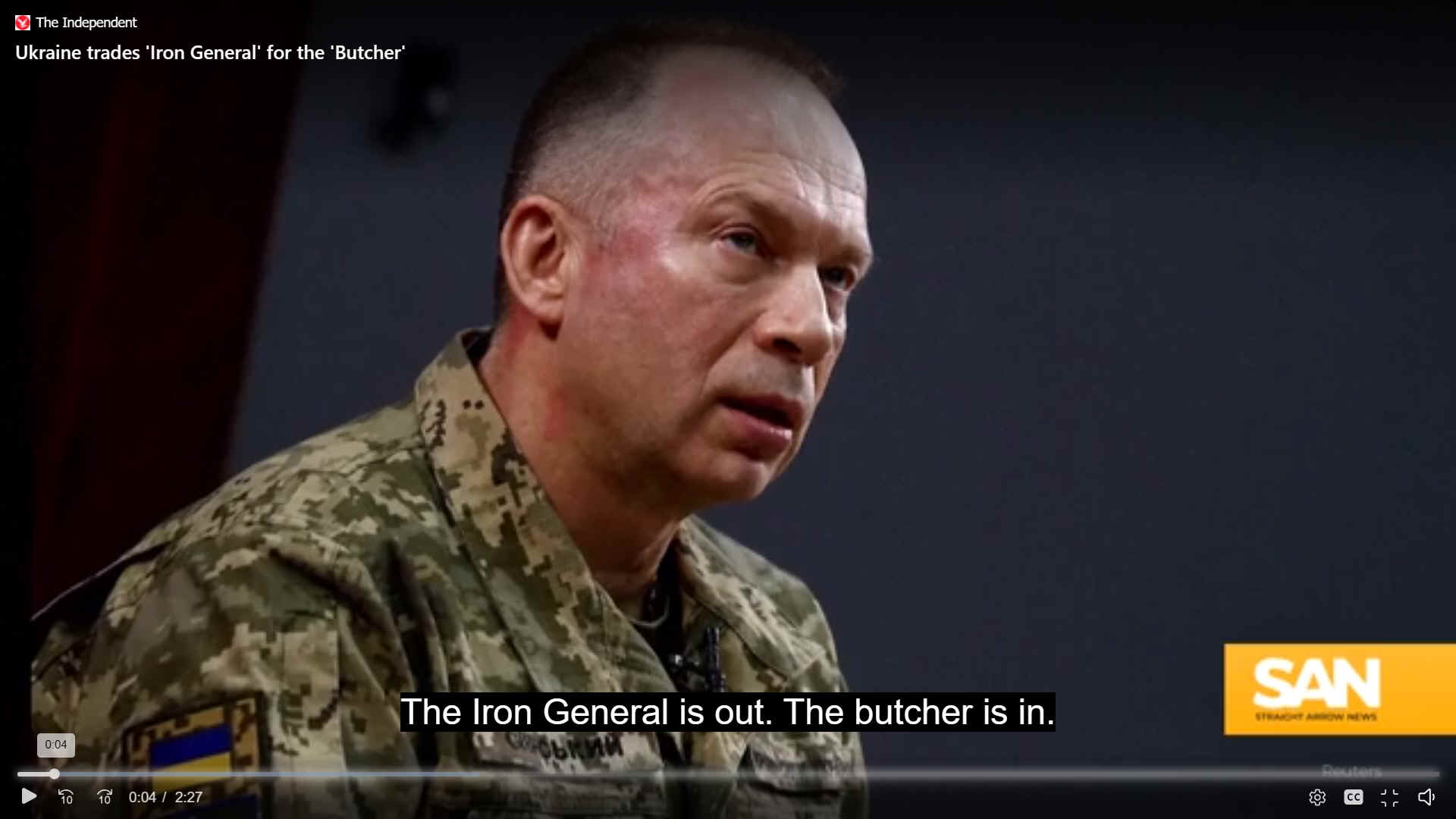
Major General Mick Ryan, who served in the Australian army for 35 years, warned Vladimir Putin's military has likely "moved ahead of the West" in areas such as the mobilisation of the Russian industry and drone warfare.
If the Kremlin managed to "outlearn" Ukraine and NATO, the war would inevitably be won by Putin, Mak Gen Ryan believes.
He told Forces.net: "What we've seen, I believe, over the last 18 months, is the Russians have not been as good at the lower-level adaptation because they centralise command and control.
"What the Russians have done, however, is moved ahead of the West in things like mobilising their industry. "They did that on September 22, 2022, with that partial mobilisation directive. Everyone looked at the conscript mobilisation but embedded in there was mobilisation of industry. So, they're a year ahead of us at least."
In September 2022, Putin placed Russians and their economy on a wartime footing as he announced a partial mobilisation in Russia.
The move prompted 300,000 Russian citizens in the military reserves called up to fight in Ukraine. But it also meant the Kremlin started scaling up production of artillery and drones.
But should Russia master the art of drone fighting and find a technology able to fully deceive Ukrainian air defences, Kyiv would face a disaster.
To prevent Russia from gaining supremacy on the battlefield, NATO must share with Kyiv its most up-to-date training and warfighting lessons to make Ukrainian soldiers fit to counter the Russian military, Maj Gen Ryan believes. For sure Russia will take advantage inn the void in military aid. They are the chess masters of exploiting weaknesses.
Drones are taking on a growing share of military
tasks, with NATO allies being dragged into the 21st Century kicking and
screaming, instead of embracing low cost border patrols. It's a brave new
world, where drones will fight other automatons, and help friendlies perform their missions. Imagine
a bullet proof infantryman able to stand out in all weathers 24 hours a
day, 365 days of the year - that does not need food. This security guard
is on constant alert, reporting movements from hostile borders as seen on
the ground. And also, being fed with information of enemy troop movements
from the air and satellites. These lightly armoured sentinels are disposable assets,
unlike the enemy troops seeking to invade your sovereign borders. They
will not only return fire against hostiles, likely taking out many
attackers in the process, but weaken the resolve of bully-boy warmongers,
conscripting their electorate to certain death - virtual murder of their
own kith and kin.
The latest Hitlerite in the world being Vladimir Putin. Now a
UN declared
War Criminal, apparently an advocate of Hitlerism. Demonstrating once
again, not to let up your guard against thugs. While also respecting the
right of every human on the planet to hold their own religious beliefs,
within their own borders, and lawfully, when travelling to far off lands -
in peace. Tolerance and understanding being the key to lasting world
peace. 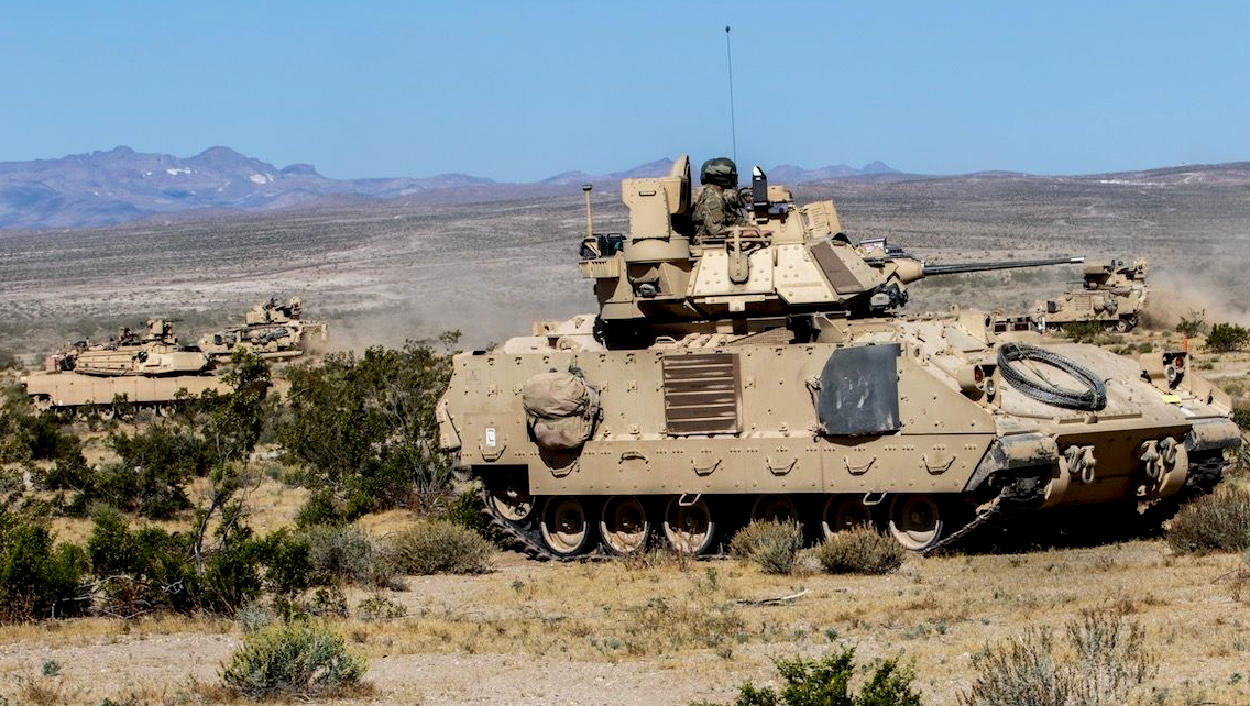
DO
WE NEED TANKS? POPULAR MECHANICS 14 FEBRUARY 2024 - COULD THE U.S. ARMY FIGHT AND WIN WITHOUT TANKS?
Would the loss of the tank force affect an army's ability to carry out essential wartime missions?
The tank is the principal offensive land weapon of AN army. According to the U.S. Army, the fundamental mission of tank units is to “close with and destroy the enemy.” This is an offensive mission that allows an army to take ground and eventually win the war. Tanks do this with a combination of speed, protection, and mobility. Speed gives tanks the ability to advance to the enemy lines, enter them, and move beyond them, while protection permits tanks to shrug off hits from enemy weapons and keep advancing. Firepower, in the form of a large-caliber main gun and machine guns, means tanks can blast away at enemy defenses, including other tanks, allowing the attack to move forward.
[The problem with this being the number of AFV's being taken out in
Ukraine by drones, etc. Tending to dilute the effectiveness of such
assets]
As of 2020, there were 73,000 tanks worldwide (not including roughly 2,500 tanks Russia has lost in Ukraine) with almost every army on Earth counting them in their inventories. The United States is currently developing a new version of the Abrams tank, the M1E3 Abrams, while Germany and France are developing the Main Ground Combat System, or MGCS. China has the ZTZ-99A2 tank, Japan the Type-10 tank, and Korea the K2 Black Panther. Although the tank has been declared dead many times in the past century, it’s clear the armies of the world continue to have faith in them.
[Well hey, they sure look good in parades and on the battlefield, just
before they are turned into scrap metal]
Today, the U.S. Army fields a total of 16 armored brigade combat teams, 11 in the active Army and 5 in the National Guard. Each consists of about roughly equal amounts of M1 Abrams tanks and M2 Bradley infantry fighting vehicles, with attached infantry dismounts. For the purposes of this theoretical exercise,
Popular Mechanics converted all the M1 tanks to M2 Bradleys.
This exercise will run a U.S. Army combined arms battalion, or a third of a brigade, up against a Russian battalion tactical group, a unit of roughly equal size, though only the Russians will have tanks. We’ll examine two different scenarios: one in which the Russians attack the Americans, and another where the American unit attacks the Russians.
The modern U.S. Army was originally structured to take on the Soviet Army, a tank-heavy, all-mechanized force that sat on the other side of the Iron Curtain opposing
NATO. The U.S. Army, from top to bottom, was designed to kill tanks, or facilitate the killing of tanks. Abrams tank? Kills tanks. Bradley fighting vehicle? Kills tanks and carries infantry that kill tanks. Apache attack helicopter? Kills tanks from the air. Blackhawk helicopter? Can carry tank-killing supplies or tank-killing infantry. And so on.
This structure still exists in the modern Army, not only because the service uses the same (updated) weapons, but because it’s oriented to fight high-end threats that still use tanks. Bradley fighting vehicles still equip TOW2B long-range anti-tank missiles, and the infantry that ride inside them are armed with Javelin anti-tank missiles and AT-4 unguided anti-tank rockets. The result is that our battalion is equipped with a total of 60 anti-tank missile systems and probably 100+ anti-tank rockets.
Most anti-tank weapons today have a hit probability of about 90 percent. If just half of
these missiles disable a Russian tank or other armored fighting vehicle, and just one-fifth of
rockets do, that adds up to 50 enemy vehicles destroyed, which is enough to gut a Russian battalion tactical group and render it no longer combat effective. And this doesn’t even factor in artillery and attack helicopter support.
Bottom line: The U.S. Army is perfectly capable of conducting a defensive mission against a peer adversary without
any support tanks.
NOW WHAT ABOUT BEING OFFENSIVE?
Offense is where it gets more tricky. This experiment takes away the Army’s main offensive tool in its toolbox, and while we still have options, attacking is much trickier without them. Is it still possible? Actually, a battle in Ukraine just last month suggests it is.
Our notional battalion is made up entirely of Bradley fighting vehicles and infantry. Bradleys were originally designed to fight alongside the Abrams tank and advance alongside the Abrams tank, consolidating ground gained in an attack by carrying infantry in an armored, moving cocoon. The Bradley is also armed with a TOW-anti-tank missile launcher and an M242 “Bushmaster” 25-mm automatic cannon. This allows the Bradley to attack targets of opportunity as it advances alongside tanks, but it does not have enough firepower to make it the main reducer of enemy defenses. Nor does it have the armored protection to advance alone, without tanks.
The 25-mm Bushmaster gun is old and scheduled to be replaced by a 50-mm gun in the Bradley’s replacement, but in January 2024, two Bradleys armed only with Bushmasters took on a T-90M, the newest operational Russian tank, and battered it so badly with their light-caliber cannons that the tank was damaged and later abandoned. This was an unexpected result, and crew training on both sides likely played a role … but it did happen.
Without tanks, a Bradley unit would have to adopt different tactics to conduct attacks. Infantry would likely operate on foot, slowing down the pace of the attack. As the infantry run into obstacles, they would call up Bradleys to destroy them, but would need to take care not to expose the Bradleys to effective anti-tank fire. The plodding pace of such an
attack - and the fact that the infantry would be out in the open - would make everyone involved vulnerable to Russian artillery strikes.
Without tanks, the U.S. Army could go only in one direction: backward. An army that can’t go forward can’t lose the war, but it can’t win the war either. The bottom line is that tanks are still invaluable in modern warfare. SO
FAR SO GOOD Enter troops that are armoured and carry missiles. The
(proposed) Drone Soldiers would displace the need for Bradley's, Abrams tanks and human
soldiers, in one foul swoop. Imagine a wave of robot soldiers advancing
against a confused Russian tank battalion. Each anti-tank drone is also a
major threat to enemy troops. Fearlessly standing ground, being ordinary
bullet proof, and picking off the soldiers, as their armoured supports are
also neutralized, the remaining troops demoralized. If not retreating,
rounded up as prisoners of war. Once
the enemy positions are destroyed, then bring up another wave of Drone
Infantry, freshly loaded with munitions to advance, while the attack wave
is withdrawn to be recharged with their full complement of weapons. And,
no casualties. There
is a way to make advancing very fast. Faster than main battle tanks. This
is proprietary know-how. This
is also, a very cost effective scenario. It's all very Zulu.
One of the best examples of a small number of disciplined soldiers, taking
on superior numbers and decimating them. Of course, it all depends on the
specification of the Drone Infantry units. The
other advantage, is that hexapods can go where tanks cannot. They can
surmount extremely rough terrain, slopes and other obstacles. 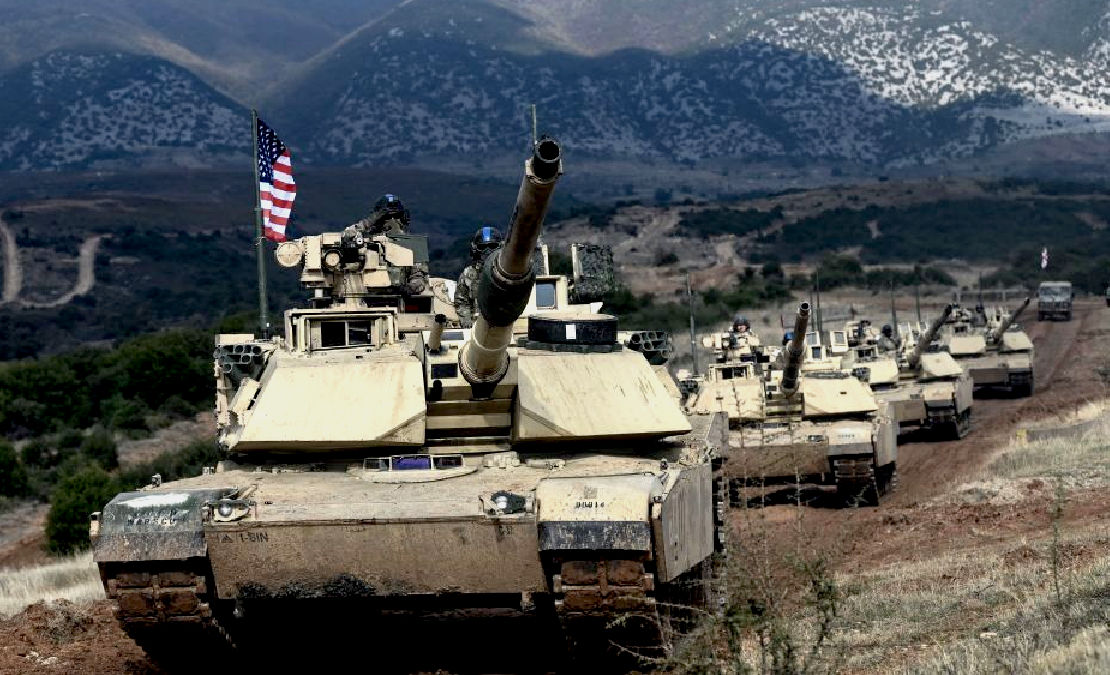
THE
PRICE OF PEACE This
war, like so many others, is really all about cost. How much does it cost
to destroy an enemy asset, compare to the cost of the asset. If the
average cost of a Russian tank is $3.5 million dollars, and the cost of a RPG-29 Vampir
is equivalent to about $2,000 in 2024. It's a no-brainer to use RPGs,
attached to an Infantry drone unit. The cost of which could be as low as
$20,00 - 50,000 dollars as a bare unit, and could take out two tanks for
$54,000 dollars in the upper price bracket, and still be ready to fire on
advancing enemy infantry with conventional machine guns, for another
$4,000. Thus, all in at under $60k. Compare
that to aerial drones, that are proving to be quite successful, also at relatively
low cost. In the end, it's hardly worth having battle tanks costing $5-6
million dollars each, when that same sum could have provided 100 mobile
armoured infantry units with RPGs, presenting a much more difficult
logistics problem for Vladimir Putin and his beleaguered generals.
Consider also, that you save the cost of training the human soldier, and
do not risk a life. The
next point to consider, is the territory captured, worth the cost of
capture? And, how much will it cost to administer, in the long term with
resistance fighters and general resentment. Is Russia entering a modern
Colonial phase? 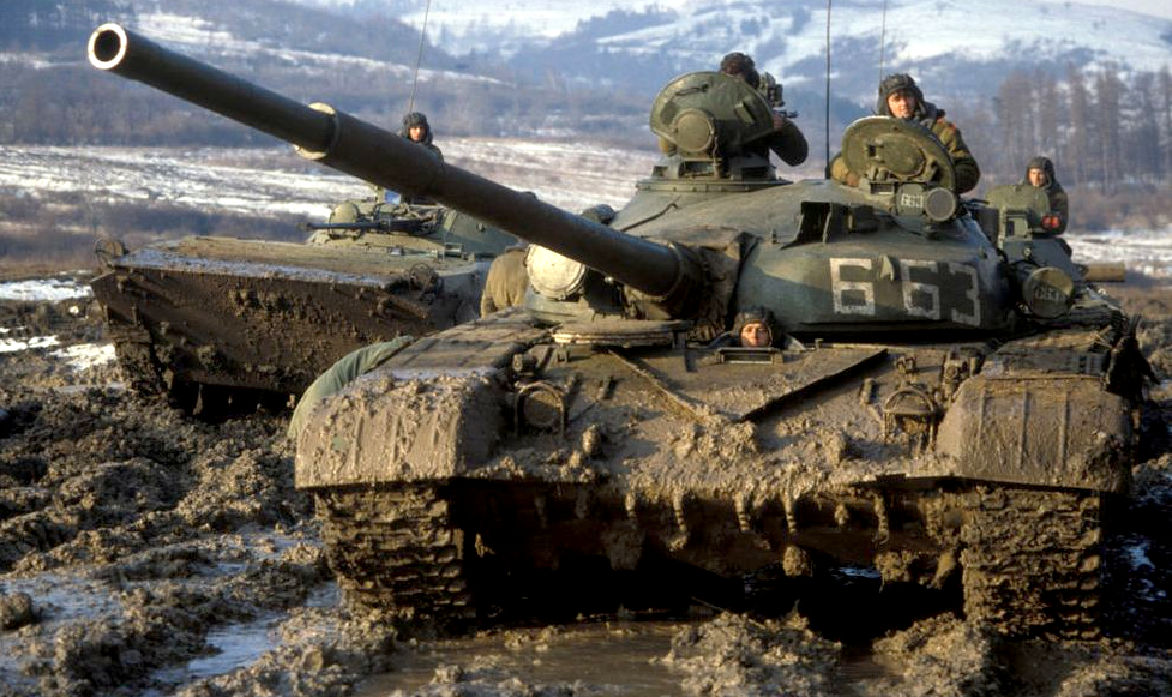
It's
not too difficult a task to convert one of the proposed DinoBots, to carry
rather more than lasers and paintball guns. NATO and Ukraine should
perhaps have seen the conflict brewing, and maybe been standing in readiness to
deploy low cost armies of anti-tank autonomous infantry units. The cost of
deploying these units needs to be significantly lower than the cost for
Russia to take them out. The days of tanks may be drawing to a close. If
NATO had had this vision, the cost of supply of armaments to Ukraine could
have been significantly reduced. With
an aggressor such as Russia, nothing is going to stop them stockpiling
cash for their kleptocratic agendas. One has to stifle their disposable
income, or make it extremely costly to wage war in terms of tanks and
troops. Russia is changing, adapting to new ways of fighting, but still
rely on stocks or outdated hardware, and bringing in younger soldiers to
replace the more experienced infantry being lost on a daily basis. Eventually,
Russia would run out of hardware and fighting men and women, if it was
that low cost, mass produced fighting units were deployed on the
battlefield, at strategic location. With the ability to deliver hundreds
of armoured robot soldiers, to take on any live human
aggressors. 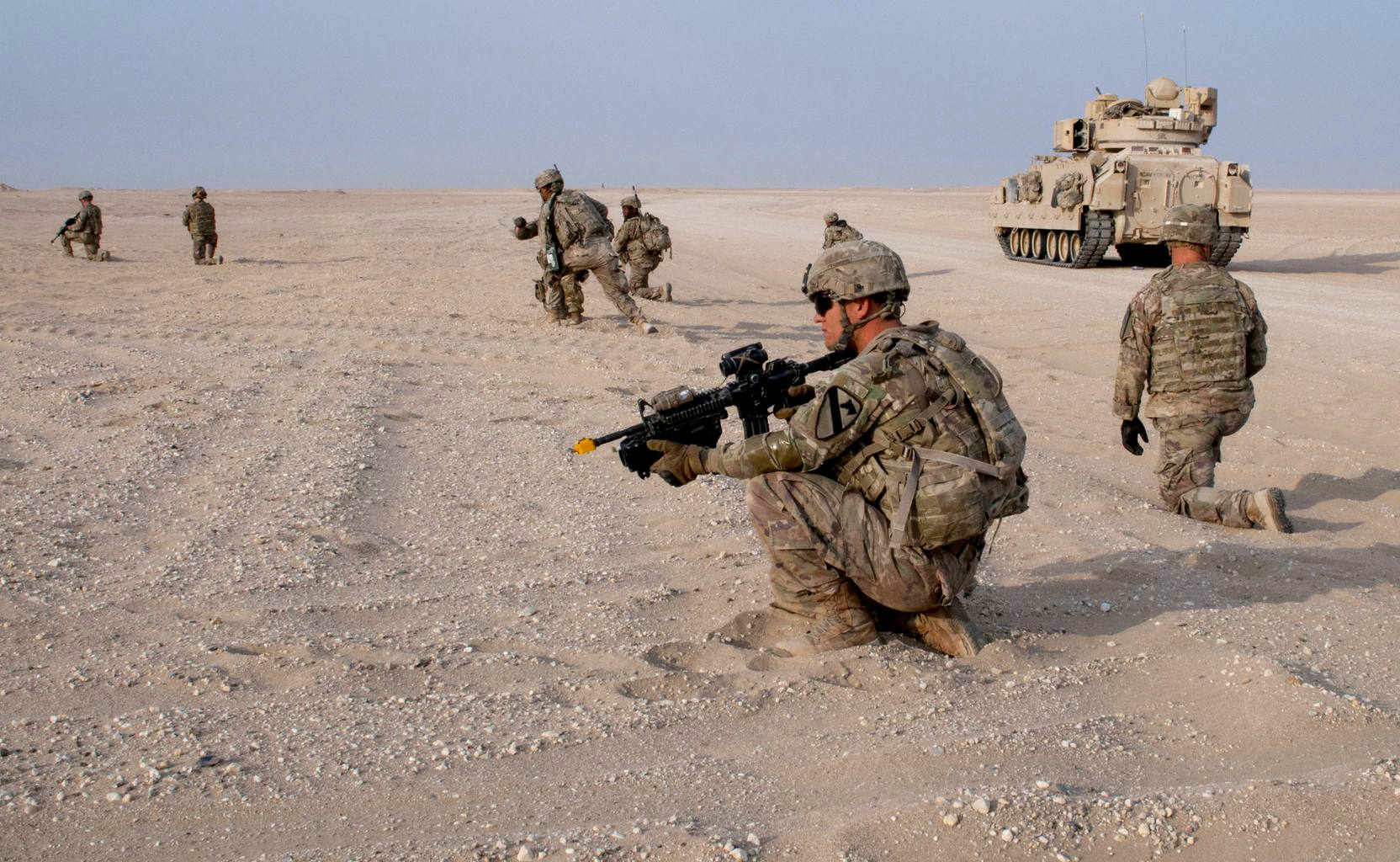
WHAT
IS THE COST OF A BATTLE TANK? The average cost of a battle tank in the Ukraine Russia conflict depends on various factors such as the type, model, age, condition, and source of the tank. However, based on some sources, here are some possible ranges of costs:
According to a RAND report, the materiel cost of the Russian invasion of Ukraine amounted to $11 billion, which included tanks, armoured vehicles, artillery, and ammunition. Assuming that Russia lost 3,000
tanks, the average cost of a Russian tank would be about $3.67 million.
According to a BBC article 5, the US provided Ukraine with 250 Patriot missiles, which cost about $3 million each. The article also mentioned that the UK supplied Ukraine with 50 Challenger II tanks, which cost about $7.9 million each. Assuming that these were the only tanks that Ukraine received from the West, the average cost of a Western tank would be about $6.45 million.
According to an ITV article4, Ukraine had about 2,000 tanks before the war, mostly Soviet-era models such as the T-64 and the T-72. The article estimated that Ukraine lost about 1,000 tanks in the first year of the war. Assuming that the remaining tanks were of similar quality, the average cost of a Ukrainian tank would be about $1.5 million.
Therefore, the average cost of a battle tank in the Ukraine Russia conflict could range from $1.5 million to $7.9 million, depending on the origin and quality of the tank. However, these are only rough estimates and may not reflect the actual market value or operational effectiveness of the tanks. The T-72, is a Soviet-era main battle tank that is the mainstay of the Ukrainian army, and the Challenger II2, a
British-made tank that was supplied to Ukraine by the UK as part of a military aid package. The T-72 is a heavily armored tank that can fire 125 mm shells, while the Challenger II is a modern tank that can fire 120 mm shells and has advanced optics and fire control systems. Both tanks have faced losses and damage from anti-tank weapons such as the RPG-29 Vampir and the 9M133
Kornet. Those losses are proof that armoured fighting vehicles (AFVs) may
have had their day. Amazing as they may be. They are the fast approaching dinosaurs
of the battlefield. 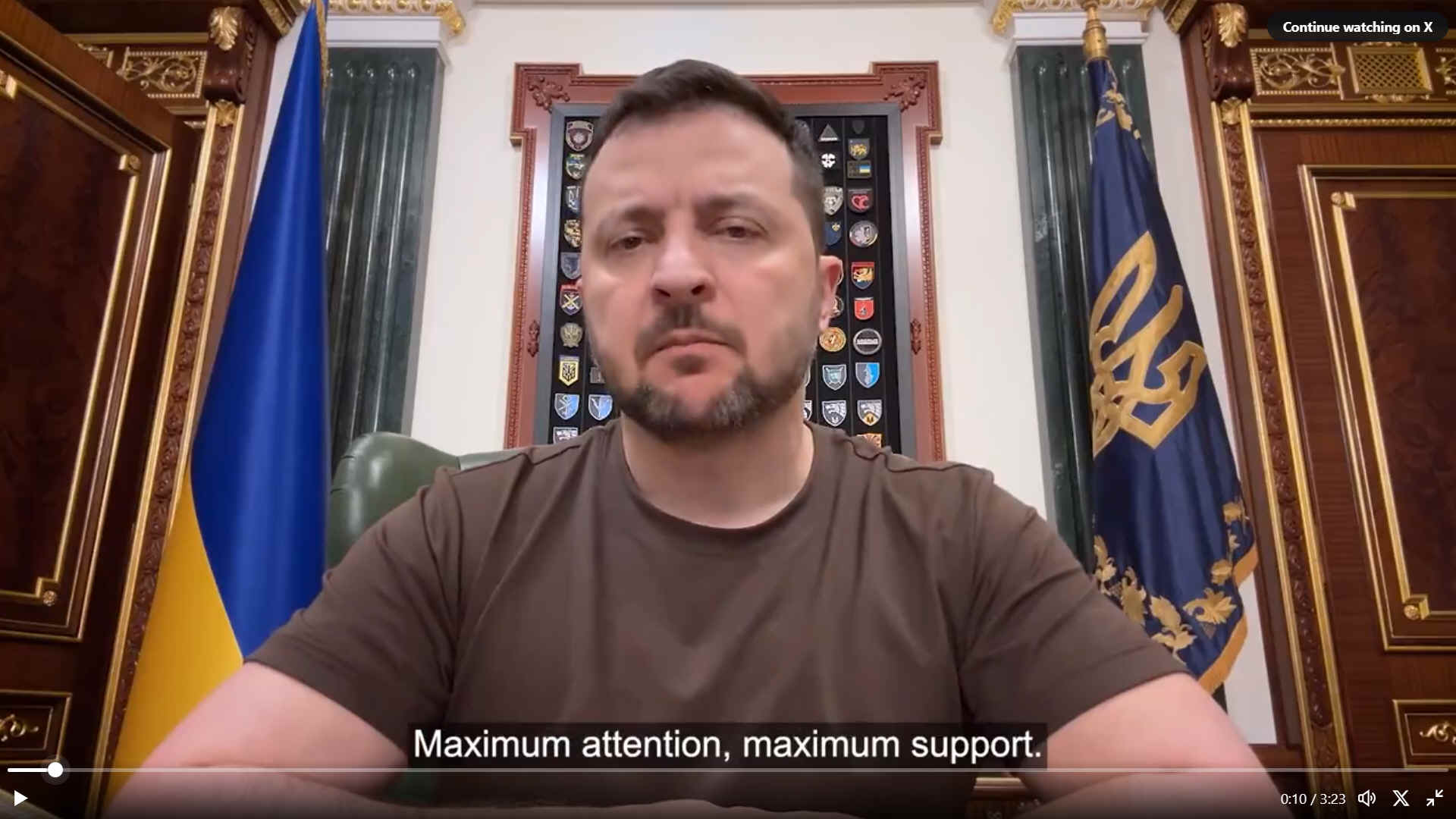
ANTI TANK WEAPONS
Anti-tank weapons are designed to destroy or disable tanks, which are heavily armored vehicles that can withstand direct fire from conventional weapons. Anti-tank weapons can be classified into two main types: kinetic energy and chemical energy
[14].
Kinetic energy weapons use the force of impact to penetrate the tank’s armor, such as bullets, shells, or rockets. Chemical energy weapons use explosives or shaped charges to create a jet of hot gas that melts or cuts through the armor, such as grenades, mines, or missiles
[14].
The effectiveness of anti-tank weapons depends on several factors, such as the type, model, range, accuracy, and angle of the weapon, as well as the type, model, armor, mobility, and countermeasures of the tank
[14] [15]. Generally speaking, anti-tank weapons are more effective when they hit the tank from the top, rear, or sides, where the armor is thinner, than from the front, where the armor is thickest
[15].
Some examples of anti-tank weapons that have been used in the Ukraine Russia conflict are:
NLAW (Next Generation Light Antitank Weapon): a shoulder-fired missile that can hit the tank from above in a top attack mode, or directly in a direct fire mode. It has a range of about 600 meters and can penetrate up to 500 mm of armor
[16].
Javelin: a shoulder-fired missile that also uses a top attack mode, but with a longer range of about 2,500 meters and a higher penetration of up to 800 mm of armor
[16].
RPG-29 Vampir: a rocket-propelled grenade launcher that fires a tandem warhead, which means it has two explosive charges: one to defeat the explosive reactive armor of the tank, and another to penetrate the main armor. It has a range of about 500 meters and can penetrate up to 750 mm of armor4.
9M133 Kornet: an anti-tank guided missile that can be launched from a tripod, a vehicle, or a helicopter. It has a range of up to 5,500 meters and can penetrate up to 1,200 mm of armor
[17].
These anti-tank weapons have proven to be valuable for the Ukrainian forces, as they have destroyed or damaged hundreds of Russian tanks in the
conflict [15] [18]. However, they are not invincible, as the tanks can also use countermeasures such as smoke screens, active protection systems, or electronic warfare to evade or intercept the incoming projectiles
[15] [15]. Therefore, the outcome of the tank battles depends not only on the weapons, but also on the tactics, training, and coordination of the combatants
[15].
|


|
LASERS -
You can purchase these generic
330mW laser diodes for around £3-4. The housing on the right is another
£3. With these prices you may as well begin experimenting with components
that you can repeat buy at sensible prices. An economic solution for wargame simulations
might be to strap 7 of these little beauties together for a 2.3w output at
a cost of £42 pounds, all focused at one point. Neat! In any event,
lasers are great for ranging and identifying targets. You ordinary DVD
burner has a laser similar to this inside. That is how it burns the disc
and that is why a Blu ray disc comes out of the machine warm, because it
has been shooting a laser at the disc to read it. |
|
|
Notes |
|


|
LEFT:
Panasonic 380mW laser diode. RIGHT: Osram's 2000mW burning laser diode, which
unfortunately also carries a singeing price tag on nearly £400. Two watts is more than
enough for wargaming - but not at that price.
All projects of this nature demand soldering skills, a basic knowledge of
electronics, and model radio control equipment. Later on, when
it comes to programming robotic functions, then we would expect that you
have some knowledge of computer programming. If not, get yourself down to Maplins, or other
good electronics retailers (online) for a crash course in
Arduino
or Raspberry
Pi robotics applications. |
WARNING
- Before building your own laser, please read up on how
dangerous they can be. You can be blinded if you do not work safely. Never
look into a laser beam. Do not shine a laser at any moving vehicle. Do not use
a laser to play with pets. This information is posted here as an educational resource.
If under 18, make sure your parents know what you are attempting.

DIY
PCBs - An
example of a laser driver circuit diagram without a potentiometer and a 4 ohm resistor.
Lasers are now used as weapons on US Navy warships
as part of their strategic development.


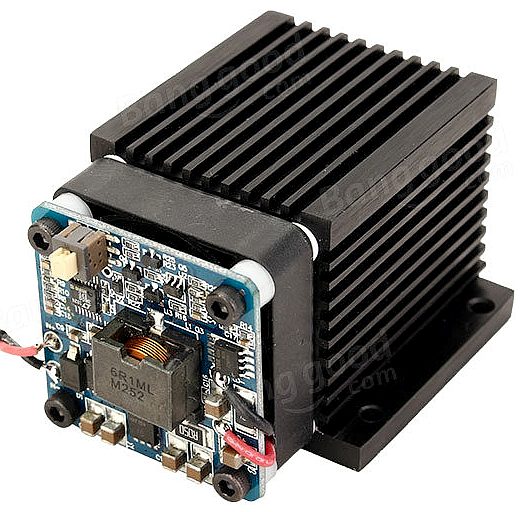
LASERS
- The power of commercially available lasers is coming down in line with
the popularity of cutting applications such as engraving. It won't be long
before this 5.5 watt unit is available in 500 watts and then 5,000 watts
power outputs. Experiments are planned using these and other units as to
their potential for anti-piracy
use on boats that are unmanned. It is better to have a weapon and not need
it, than need a weapon and not have it.

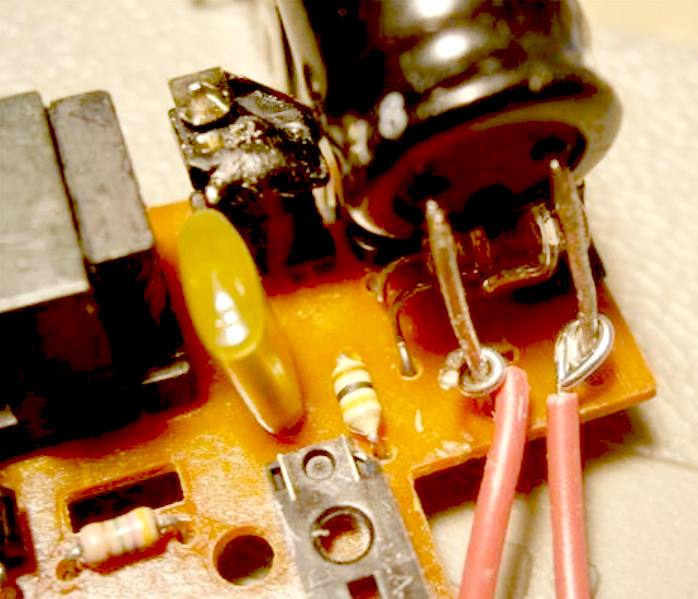
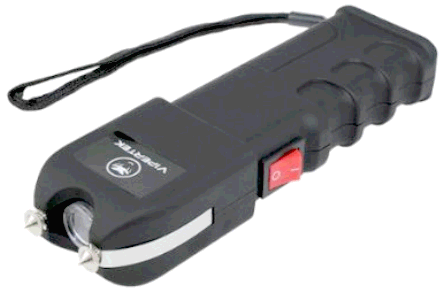
TASERS
- The X26 the model commonly used by police departments delivers a peak voltage of 1200 V to the body.
They use barbs to establish a circuit, fired from the gun by compressed
gas. The gun generates a series of 100-microsecond pulses at a rate of 19 per second. Each pulse carries 100 microcoulombs of charge, so the average current is 1.9
milliamperes, too force the muscles to contract without risking electrocution
- so they say! Stun guns generate a high-voltage, low-amperage electrical charge. You may remember an experiment like this in school where you joined hands to complete a circuit.
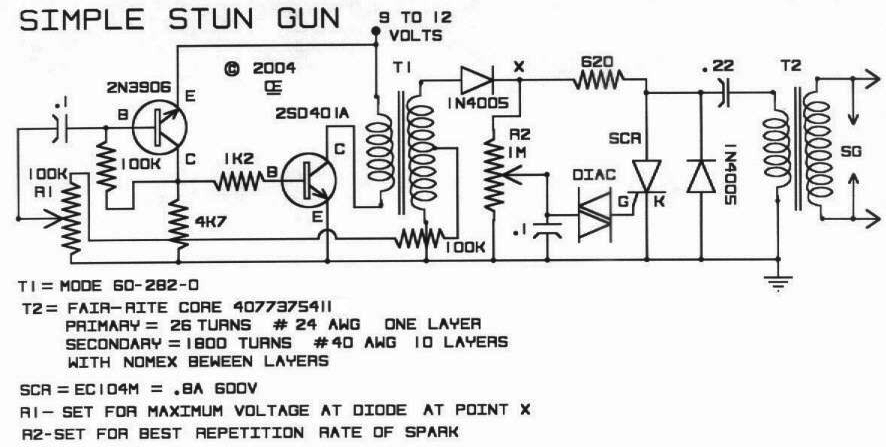
A
20,000 - 150,000 volt charge combines with the electrical signals from a human brain to confuse it. At its most basic, this is all there is to incapacitating a person with a stun gun - you apply electricity to a person's muscles and
nerves, and since there are muscles and nerves all over the body, it usually has some effect.
The Taser takes advantage of two natural protections against electrocution that arise from the difference between skeletal and cardiac muscle. The skeletal muscles are on the outer shell of the body; the heart is nestled farther inside. In your upper body, the skeletal muscles are arranged in bands surrounding your rib cage. Because of skeletal muscle fibers' natural inclination to conduct low-frequency electricity along their length, a larger current injected into such a muscle tends to follow the grain around the chest rather than the smaller current that penetrates toward the
heart - that would of course be deadly. On the other hand, studies have shown that stun guns were used during about 30 percent of in-custody deaths in the United States.
The Taser is not considered to be a firearm in 44 US states where they can
be carried lawfully. The Czech Republic encourages vulnerable persons to
carry such devices for self protection. You can make your own stun device
from a gas lighter or a camera flash - but these experiments are much more
dangerous than the commercial product that you cannot purchase in many
countries.
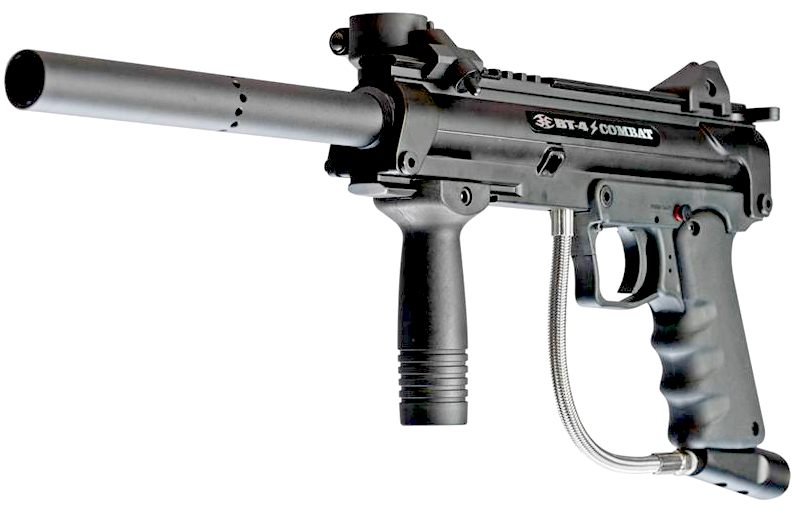
PAINTBALL
- is a sport in which players compete, in teams or individually, to eliminate opponents by tagging them with capsules containing water-soluble dye and featuring a gelatin outer shell (referred to as paintballs) propelled from a device called a paintball marker (commonly referred to as a paintball gun). Paintballs are composed of a non-toxic, biodegradable, water-soluble polymer. The game is regularly played at a sporting level with organized competition involving major tournaments, professional teams, and players.
WHAT
ARE THE DEVELOPMENTAL CHALLENGES
With human-operated remote-controlled robot infantry units, several significant challenges remain:
Ethical Considerations:
- Psychological Impact: Operators remotely controlling lethal robots might experience trauma and moral distress, similar to soldiers on the battlefield.
-
Dehumanization and Distance: The physical detachment from the act of killing could desensitize operators and blur the lines of responsibility, potentially leading to increased violence. -
Accountability: Determining responsibility for actions (e.g., civilian casualties) remains complex, even with human operators in the loop.
Practical Challenges:
- Latency and Lag: Delays in communication between operator and robot can lead to mistakes and unintended consequences. -
Vulnerability to Hacking and Disruption: Remote-controlled systems are susceptible to hacking or jamming, potentially leading to loss of control or friendly fire incidents. -
Cost and Complexity: Developing and deploying effective robot infantry units remains expensive and requires significant technological expertise.
Alternatives to Consider:
- Ceasefire and Negotiations: Prioritizing diplomatic efforts, ceasefire agreements, and negotiations remain crucial for ending the conflict and saving lives. -
Humanitarian Aid and Support: Increasing humanitarian assistance to impacted communities and supporting refugees is essential to alleviate suffering. -
Strengthening International Law and Norms: Holding violators of international law accountable and upholding principles of distinction and proportionality are crucial for protecting civilians.
Beyond these points, it's important to emphasize that technology cannot address the root causes of conflict. Addressing social, economic, and political grievances through dialogue and cooperation is essential for long-term peace.
Focusing solely on casualties masks the broader human cost of war. The impact on families, communities, and societies extends far beyond immediate deaths and injuries.
While technological advancements can offer potential solutions, true security comes from building peaceful societies, not through escalating the use of force.
....
MORE
INFO ABOUT THE NATO-UKRAINE-RUSSIA CONFLICT & PROPOSALS FOR ANTI-TANK
DRONE INFANTRYMEN
The NATO-Ukraine-Russia conflict is a war that started in 2023 when Russia invaded Ukraine, violating its sovereignty and territorial
integrity [1]. NATO and its allies have condemned Russia’s aggression and provided Ukraine with political and military support, including humanitarian aid, non-lethal equipment, and lethal
weapons [1] [2]. The conflict has caused massive casualties, displacement, and destruction on both sides, as well as global instability and energy
crisis [2] [3].
Anti-tank drone infantrymen are small, portable, and lethal unmanned aerial systems that can fly, track, and engage armored vehicles with precision
fires [4]. They are also known as loitering munitions or kamikaze drones, as they are designed to explode on impact with the
target [5]. Some examples of anti-tank drone infantrymen are the US Army’s
LASSO [4], the AeroVironment Switchblade [6], and the Raytheon Javelin
[7]. Based on this information, I can speculate on some possible reasons why NATO or Ukraine have not thought to deter Russian aggression with small mass-produced anti-tank drone infantrymen. However, these are only my guesses and not facts, so please take them with a grain of salt.
One possible reason is that anti-tank drone infantrymen are not widely available or affordable for NATO or Ukraine. According to some sources, the US Army is still developing and testing its LASSO program, and it expects to field the system in
2024 [4] [8]. The AeroVironment Switchblade and the Raytheon Javelin are also relatively new and expensive weapons, and they may not be compatible with the existing platforms and doctrines of
NATO or
Ukraine [6] [7].
Another possible reason is that anti-tank drone infantrymen are not effective or reliable enough to deter Russian aggression. According to some experts, anti-tank drone infantrymen have limitations in terms of range, endurance, payload, and survivability. They may also face challenges in operating in contested airspace, adverse weather, and complex terrain. Moreover, they may pose ethical and legal dilemmas in terms of proportionality, discrimination, and
accountability [5].
A third possible reason is that anti-tank drone infantrymen are not sufficient or appropriate to deter Russian aggression. According to some analysts, anti-tank drone infantrymen are mainly useful for tactical engagements, but they may not have a significant impact on the strategic outcome of the war. They may also escalate the conflict and provoke a stronger response from Russia, which has superior conventional and nuclear forces. Furthermore, they may not address the root causes of the conflict, such as political, economic, and social
issues [5].
....
We were thinking of much lower cost robot infantry, land army, where the small armoured units could be deployed at borders and other hotspots, delivered by trucks the same way human soldiers are brought to a battlefield. The cost of much smaller drone controlled units, if mass produced, is typically less than any single
missile, save for RPGs, and can be armed with low cost RPGs and other weapons, which
may be lower in price compared to aerial drones. 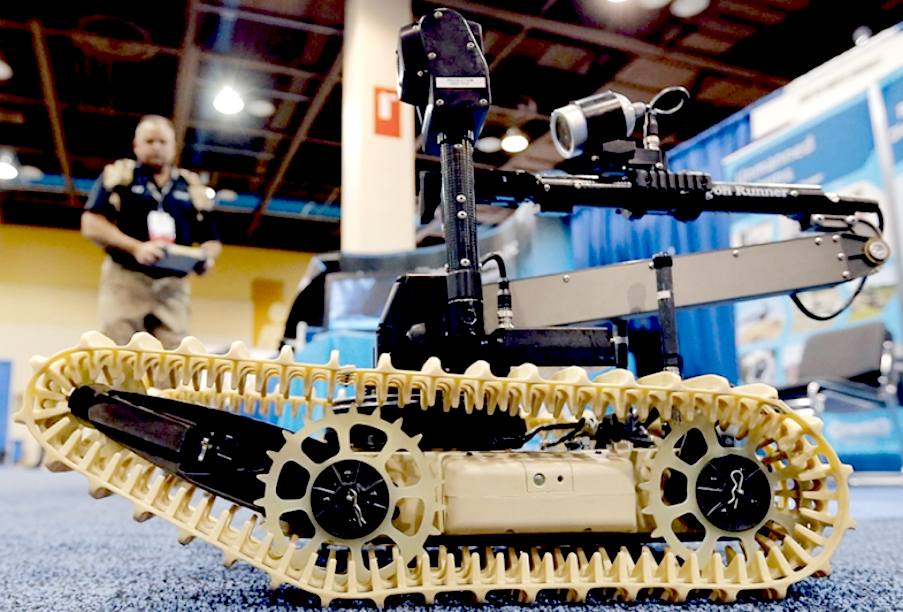
OTHER GROUND SUPPORT ROBOTS
Robot infantry, land army, are ground robots that can support human soldiers in various tasks, such as carrying equipment, providing surveillance, engaging targets, and evacuating
casualties.
Some examples of robot infantry, land army, are the US Army’s Small Multipurpose Equipment Transport (S-MET), which can carry up to 1,000 pounds of supplies and operate for 60 miles over 72
hours, and the UK Army’s Multi-Utility Tactical Transport (MUTT), which can be fitted with sensors, weapons, or medical
equipment.
Robot infantry, land army, have some potential advantages, such as reducing the physical and cognitive burden on human soldiers, enhancing situational awareness and force protection, and increasing mobility and
firepower.
Robot infantry, land army, also have some potential challenges, such as ensuring interoperability, reliability, and security of the systems, maintaining human control and oversight, and addressing ethical and legal
implications.
As to the idea of using small mass-produced anti-tank drone infantrymen to deter Russian aggression, one possible thought is that the idea is feasible and cost-effective, as it could leverage the existing technology and infrastructure of robot infantry, land army, and modify them to carry anti-tank weapons, such as RPGs. This could create a large number of low-cost, high-impact units that could pose a serious threat to Russian armored vehicles and deter their advance.
Another possible thought is that the proposal is risky and provocative, as it could escalate the conflict and invite a stronger retaliation from Russia, which has superior air and cyber
capabilities at the present time. This could expose the robot infantry, land army, to attacks from above and below, and compromise their effectiveness and safety.
It is better to have a weapon and not need it, than need it and not have
it. Traditional military thinking prevents progress, where they like large
armoured machines and aircraft carriers. It looks good and boosts morale.
But if a tank costing several
We should though, not neglect the root causes and the broader context of the conflict, such as the political, economic, and social issues that fuel the tension and violence. This could undermine the prospects of a peaceful and lasting resolution, and instead perpetuate a cycle of hostility and mistrust. Furthermore, your idea could divert resources and attention from other more constructive and cooperative measures, such as diplomacy, sanctions, and dialogue. 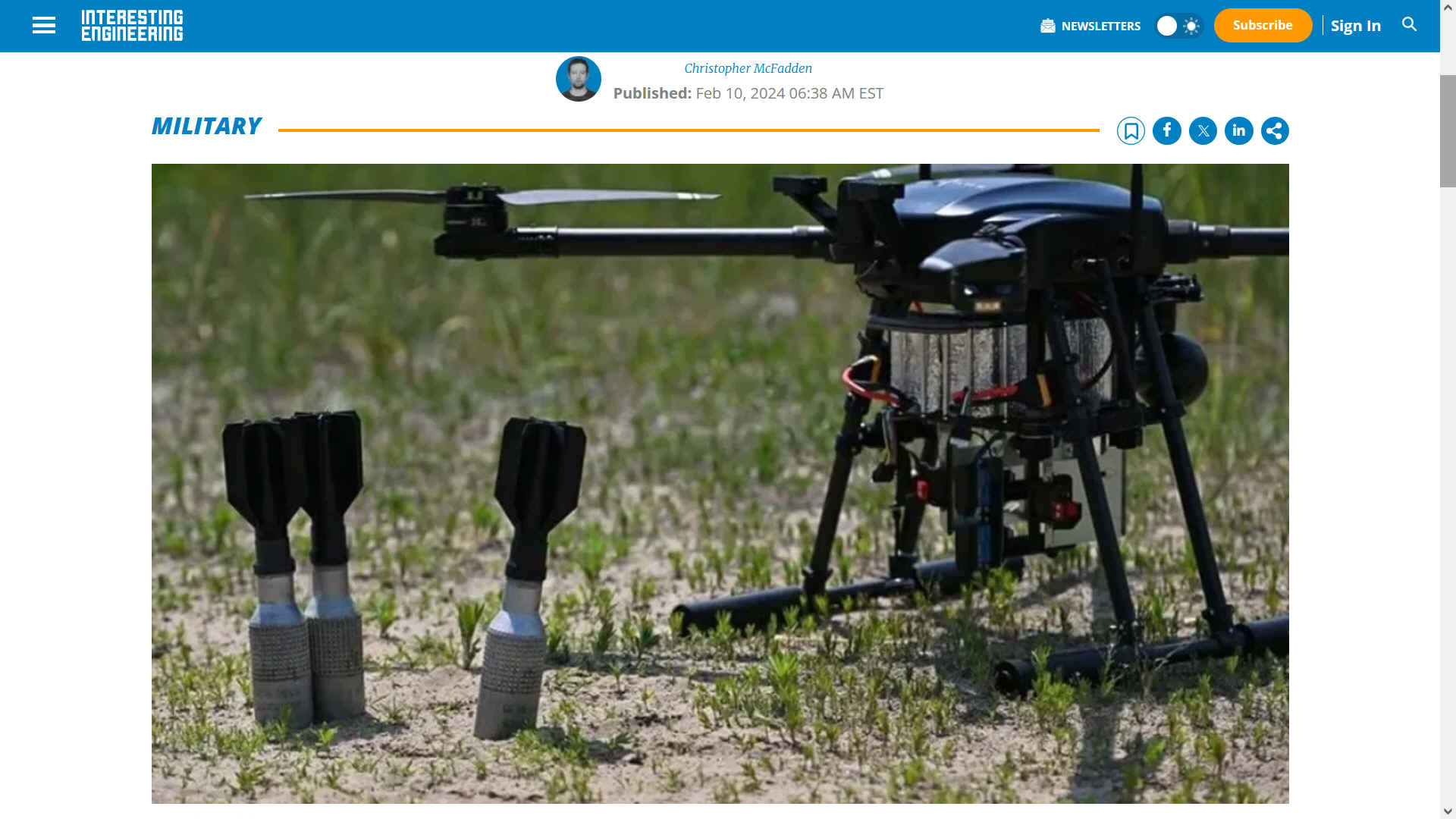
INTERESTING ENGINEERING 10 FEBRUARY 2024 - MEET THE SHOOLIKA MK6: UKRAINE'S
EW- TOUGHENED, NIGHT VISION DRONE
A Ukrainian drone maker, Brave Inventors, has unveiled its latest Shoolika (meaning "Kite") Mark 6 drone. Electronic warfare-resistant, the new combat drone also sports impressive night vision capabilities. This combination makes this
drone a true force to be contended with in hot combat zones like Ukraine.
Founded in December 2022, Brave Inventions, the company reports, has created more than five innovations every week since. Brave
Inventors aims to promote Ukrainian defense technology innovation and assist early-stage Ukrainian start-ups in developing breakthrough defense technologies, such as
AI-based
autonomous decentralized systems.
The Ukrainian Minister of Digital Transformation, Mykhailo Fedorov, announced the Shoolika MK6 system on Telegram on February 5, which, he claims, can launch precise strikes even during nighttime operations. “The Defense Forces have already tested the Shoolika MK6 and offered their feedback: the drone is important for tactical operations, especially at night,” Fedorov said (translated from Ukrainian).
Federov explained on the Telegram post that the drone is currently undergoing NATO codification and will receive updates to enhance its artificial intelligence and camera capabilities for more effective use in tactical operations. Capable of carrying payloads up to 13 pounds (6 kilograms) and operating up to 6 miles (10 kilometers) away, the Shoolika MK6 is, Federov states, a versatile solution. 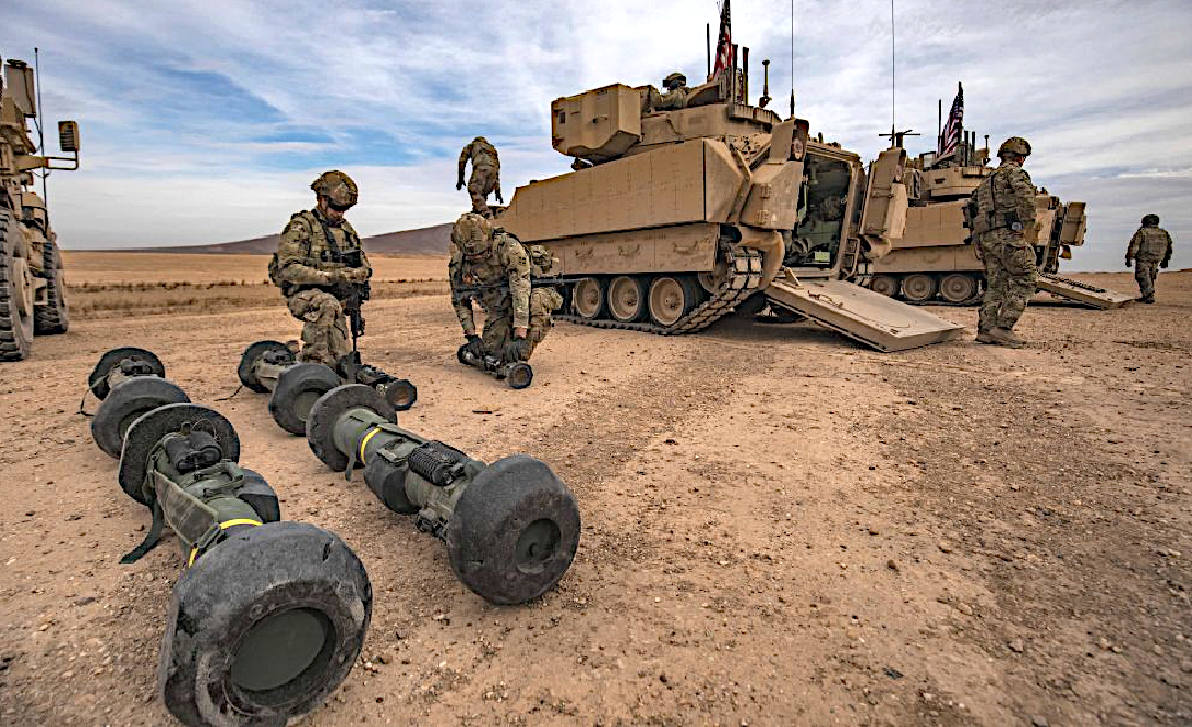
A
MILLION MORE ON THE WAY
Ukraine has been using drones to counter Russian forces as a way to reduce casualties in battle. Ukrainian President Volodymyr Zelensky has ordered the creation of a new military branch dedicated to unmanned and robotic
air, sea, and ground systems.
As IE reported in December 2023, Ukrainian officials have committed to ramping domestic drone production into the millions by year's end. At the time, the Ukrainian Minister for Strategic Industries, Oleksandr Kamyshin, announced on social media that the country plans to increase its production of first-person view (FPV) crafts for attack and reconnaissance purposes. The move is part of a larger plan to defend Ukraine from the Russian Armed Forces.
"And this is only about FPV drones. Already in December, we produced more than 50 thousand FPV drones. In addition to FPV drones, we are already able to produce more than 10,000 mid-range strike drones (hundreds of km) and 1,000+ drones with a range of 1,000 km in the next year. All production capacities are ready, and contracting for 2024 begins," his Telegram post stated (translated from Ukrainian).
To this end, 2023 was filled with news of new Ukrainian drones, like the Shoolika Mark 6, including, but not limited to, a new kamikaze drone with a reported range of 466 miles (750 km). Called the AQ 400, this new drone can be launched using short runways or catapults, carrying payloads up to 70 pounds (32 kg). The drone can fly at 85 miles (140 km) per hour. Its payload capacity can be increased by reducing the drone's range.
Ukraine's drones have already been shown to be very effective, with some being used to destroy a long-range supersonic bomber and an
oil tanker in the Kerch Strait loaded with fuel in the past. MORE
WORK NEEDED
Ukraine's future plans, Defense Express reports, include improving the AI system for autonomous missions and upgrading cameras to enhance target identification and course adjustment for aerial strikes.

Diplomacy has failed, maybe was never an option. It appears that Russia has been slowly building up weapons, with a view to attacking Ukraine, as part of an empire expansion, fueled by oil and gas sales. Economic sanctions have also failed, where the war has dragged on for two years. We feel sure that Europe, UK and the USA knew an attack was imminent, but still failed to put in place technology which would have saved human lives - and possibly even put the aggressors off before they even began their offensive. Hence, developing alternative energy would be one way of cutting off finance, but otherwise, it appears that NATO should have been more prepared technology wise.
Other factors and challenges tend to complicate the issues. There may not be a simple or easy solution to the conflict. ��
For example, some of the factors and challenges to consider are:
- The historical, cultural, and ethnic ties between Russia and Ukraine, and the disputed status of Crimea and Donbass .
- The geopolitical and economic interests of Russia and its allies, such as China and Iran, and their opposition to NATO’s expansion and influence .
- The legal and ethical implications of using force or intervention, and the potential risks of escalation and retaliation .
- The technological and cyber vulnerabilities of both sides, and the possibility of
cyberattacks, misinformation, and sabotage .
a six legged, hexapod robot infantryman, where insects are very fast across uneven terrain. Much more adaptable than tracked vehicles, and a bipedal design like a dinosaur, is inherently unstable without a complex electronic balancing system. 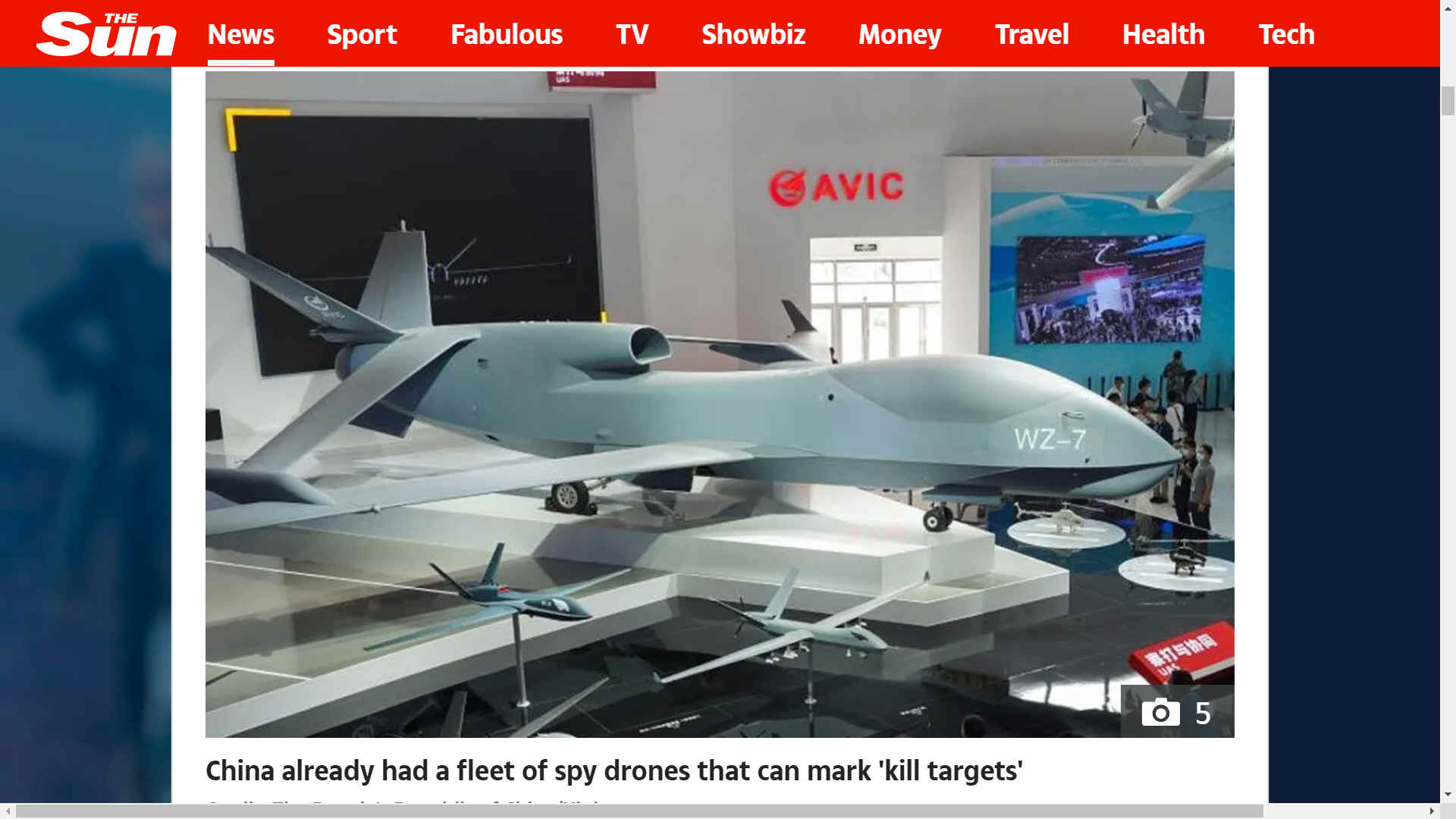
THE SUN 5 FEBRUARY 2024 - SPEC OPS BOTS - CHINA UNVEILS PLAN FOR ROBOT SAS WITH AI COMMANDOS & HIGH TECH DRONES TO REPLACE HUMANS BY 2035
CHINA seems to be on its way to replacing human soldiers completely in modern warfare scenarios.
The country has revealed shocking plans for advanced robot soldiers and high-tech drones to be sent to complex overseas missions within the next 10 years.
The Chinese People's Liberation Army (PLA) - the armed wing of Xi
Jinping's Chinese Communist Party - has been working closely with scientists to develop new-age drones that can replace humans completely in complex military missions.
The drones would have the ability to fly long distances, go deep inside water and remain unseen for longer before emerging swiftly again when need be, the SCMP reports.
At command, these drones would race towards the target, deliver a fatal blow, and return back underwater before disappearing in the waves again. by the enemy.
A recent paper published by the PLA details a hypothetical overseas special operations plan where such advanced warfare techniques could be leveraged.
According to the scenario, in 2035, a minor conflict breaks out between China and one of its neighbouring countries.
Both sides agree to use only small arms, such as small boats, drones, and anti-aircraft guns, to keep the expenses low and prevent wider escalations.
There is a long river with great depths flowing between China and its enemy - and the Chinese army has been assigned a special operation to launch a swift, silent attack across the rivers.
The target is a critical military installation that lies hidden along the river.
For this operation, the PLA argues that purpose-built drones would be the most efficient choice for the Chinese Army to go on such missions.
They must be designed for special operations, operate alone or in swarms, navigate river depths, evade detection, and launch torpedoes at enemy boats.
To remain unseen, they must stay close to the riverbed, staying submerged for long periods and navigating obstacles such as reefs with ease.
The PLA also suggests they require the drones to have advanced intelligence, surveillance, and reconnaissance (ISR) systems to hover over the battlefield, assess damage, and determine if further action is necessary after the initial attack.
If the enemy forces attempt to flee, the drones must also be capable of pursuing and eliminating them, ensuring complete victory before returning to Chinese territory.
The Chinese military has now entered the drone warfare arms race - and aims to overwhelm competitors with vast numerical superiority.
According to PLA, the special drone project has already landed, and more such advanced equipments are being developed.
China has a plethora of advanced drone systems that can wreak havoc in a warzone without having to send human soldiers.
One such is the gun-wielding robot dog that can be deployed anywhere in urban warfare scenarios.
The battle-ready bionic dog is believed to behave a Chinese QBB-97 light machine gun mounted to its back, according to WarZone.
And the terrifying weapon can reportedly fire up to 650 rounds a minute.
Another such warfare drone is China's "Robo-Shark" powered by a bionic tailfin to spy on enemy ships and hunt US Navy submarines.
The underwater robot looks like a small shark and its fin has been specially built to replace the traditional propeller.
It comes as China has been ramping up its military capabilities which could pose a serious threat to the world.
Just a few months ago, a Pentagon report claimed the country is planning to double up its nuclear arsenal in just six years - and have enough nukes to destroy the world 10 times over.
The nation may also be exploring the development of non-nuclear intercontinental ballistic missiles (ICBM), according to the report.
Former CIA China expert, Dennis Wilder, expressed concern about the warning on conventional ICBMs as they could destabilise the military balance and complicate the situation for military planners.
"China could, in a US-China crisis, for the first time threaten strikes against major US population centres without having to cross the nuclear threshold, which risks a massive US nuclear barrage in response," Wilder told the Financial Times.
Conventional ICBMs can also cause another problem, in which they “would likely be indistinguishable from their nuclear ICBMs”.
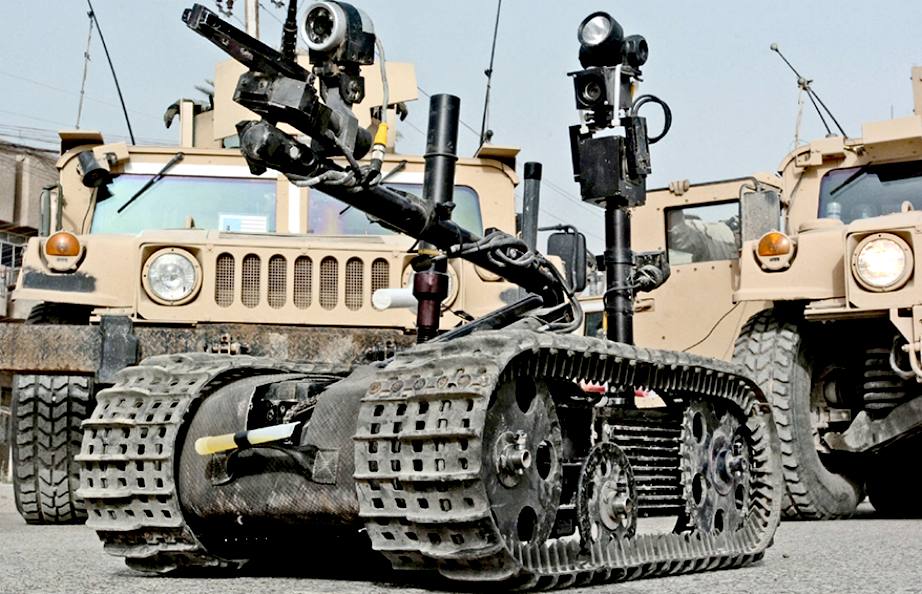
TALON
- It's pretty much a gun on wheels. That above robot is called the Talon and is actually in use by the
American
army. Though it's more like a Dalek than a T-1000, it's still pretty intimidating to the enemy to be faced with an uncaring robot enemy that won't even take the time to flinch or look grim as it fires in your direction.
Unsurprisingly the idea of robot involvement in war is already garnering opposition from groups such as the International Committee for Robot Arms Control (ICRAC), founded by academics in the forefront of robotics, who know what machines are capable of. They argue that "machines should not be delegated with the decision to kill or use violent force".
LINKS
& REFERENCE https://www.gov.uk/government/news/army-start-biggest-military-robot-exercise-in-british-history-defence-secretary-announces
https://www.army.mod.uk/news-and-events/news/2022/03/what-next-for-army-robotics-and-autonomous-systems/
https://www.unmannedsystemstechnology.com/2022/11/robotic-infantry-support-vehicle-delivered-to-us-army/
https://www.defensenews.com/land/2019/10/31/heres-the-robotic-vehicle-that-will-carry-equipment-for-us-troops/
https://www.nationaldefensemagazine.org/articles/2023/12/12/army-lays-out-plans-for-robotic-combat-vehicles https://www.msn.com/en-us/news/world/ukraine-russia-war-live-zelensky-praises-60bn-aid-granted-by-vital-us-senate-vote/ar-BB1i8OSk [1]
https://www.theguardian.com/world/2024/feb/14/russia-ukraine-war-at-a-glance-what-we-know-on-day-721
[2] https://www.express.co.uk/news/world/1866214/russia-ukraine-war-intercepted-phone-calls
[4] https://www.c4isrnet.com/unmanned/uas/2023/07/31/us-army-developing-lasso-tank-killing-drone-for-infantry/
[5] https://theaviationist.com/2022/03/10/ukraine-anti-armor-ambush/
[6] https://www.wearethemighty.com/mighty-trending/javelin-anti-tank-missile-drone/
[7] https://www.thedefensepost.com/2023/07/10/us-army-tank-kamikaze-drone/
[8] https://www.thedefensepost.com/2023/08/11/us-army-drone-variants/
[9] https://www.nato.int/cps/en/natohq/topics_192648.htm
[10] https://www.nato.int/docu/review/articles/2022/07/07/the-consequences-of-russias-invasion-of-ukraine-for-international-security-nato-and-beyond/index.html https://www.thesun.co.uk/news/25724742/china-robot-ai-high-tech-drones/ [14]
https://www.iwm.org.uk/history/why-have-ukrainian-atgms-destroyed-so-many-russian-tanks
[15] https://theconversation.com/how-do-anti-tank-missiles-work-and-how-helpful-might-they-be-for-ukraines-soldiers-178886
[16] https://mwi.westpoint.edu/on-killing-tanks/
[17] https://en.wikipedia.org/wiki/Anti-tank_gun
[18] https://www.britannica.com/technology/antitank-weapon [14]
https://www.iwm.org.uk/history/why-have-ukrainian-atgms-destroyed-so-many-russian-tanks
[15] https://theconversation.com/how-do-anti-tank-missiles-work-and-how-helpful-might-they-be-for-ukraines-soldiers-178886
[16] https://mwi.westpoint.edu/on-killing-tanks/
[17] https://en.wikipedia.org/wiki/Anti-tank_gun
[18] https://www.britannica.com/technology/antitank-weapon https://www.rand.org/pubs/research_reports/RRA2421-1.html
https://www.standard.co.uk/news/politics/vladimir-putin-ukraine-russia-war-tanks-lost-british-b1138824.html
https://news.sky.com/story/russia-has-lost-3-000-tanks-in-war-as-world-entering-more-dangerous-period-13070513
https://www.itv.com/news/2023-02-22/counting-the-cost-of-the-war-in-ukraine-a-year-on-from-russias-invasion
https://www.bbc.com/news/world-europe-62002218 https://interestingengineering.com/military/meet-the-shoolika-mark-6 https://www.popularmechanics.com/military/weapons/a46585145/us-army-without-tanks/ https://interestingengineering.com/military/meet-the-shoolika-mark-6 https://www.rand.org/pubs/research_reports/RRA2421-1.html
https://www.standard.co.uk/news/politics/vladimir-putin-ukraine-russia-war-tanks-lost-british-b1138824.html
https://news.sky.com/story/russia-has-lost-3-000-tanks-in-war-as-world-entering-more-dangerous-period-13070513
https://www.itv.com/news/2023-02-22/counting-the-cost-of-the-war-in-ukraine-a-year-on-from-russias-invasion
https://www.bbc.com/news/world-europe-62002218 https://www.thesun.co.uk/news/25724742/china-robot-ai-high-tech-drones/ https://www.gov.uk/government/news/army-start-biggest-military-robot-exercise-in-british-history-defence-secretary-announces
https://www.army.mod.uk/news-and-events/news/2022/03/what-next-for-army-robotics-and-autonomous-systems/
https://www.unmannedsystemstechnology.com/2022/11/robotic-infantry-support-vehicle-delivered-to-us-army/
https://www.defensenews.com/land/2019/10/31/heres-the-robotic-vehicle-that-will-carry-equipment-for-us-troops/
https://www.nationaldefensemagazine.org/articles/2023/12/12/army-lays-out-plans-for-robotic-combat-vehicles https://www.msn.com/en-us/news/world/ukraine-russia-war-live-zelensky-praises-60bn-aid-granted-by-vital-us-senate-vote/ar-BB1i8OSk [1] https://www.theguardian.com/world/2024/feb/14/russia-ukraine-war-at-a-glance-what-we-know-on-day-721
[2] https://www.express.co.uk/news/world/1866214/russia-ukraine-war-intercepted-phone-calls
[4] https://www.c4isrnet.com/unmanned/uas/2023/07/31/us-army-developing-lasso-tank-killing-drone-for-infantry/
[5] https://theaviationist.com/2022/03/10/ukraine-anti-armor-ambush/
[6] https://www.wearethemighty.com/mighty-trending/javelin-anti-tank-missile-drone/
[7] https://www.thedefensepost.com/2023/07/10/us-army-tank-kamikaze-drone/
[8] https://www.thedefensepost.com/2023/08/11/us-army-drone-variants/
[9] https://www.nato.int/cps/en/natohq/topics_192648.htm
[10] https://www.nato.int/docu/review/articles/2022/07/07/the-consequences-of-russias-invasion-of-ukraine-for-international-security-nato-and-beyond/index.html
ANTICS - ARDUINO - ARMOUR - ARTWORK - BLACK
BOX - CHAT
GPT - ELECTRONICS - ENERGY - FRAME
HEAD - INVISIBILITY - JAWS - KITS - LEGS - MECHANICS - MOTORS - RASPBERRY
Pi - R/C
DRONE - SENTRY - SOFTWARE
SIM
CARDS - SMARTPOHNES - SOUND
PROOFING - SPACE
ROVERS - SPEED - SUSPENSION - TAIL - WEAPONS - WARGAMING

A
Sectasaur™ (thawed) - now on permanent display at Herstmonceux
Museum, in Sussex, England.
DINOSAURS
- DOLPHINS
- HUMANOIDS
- RAYS
- SHARKS
- WHALES
ARDUINO
- ARM
HOLDINGS - BEAGLEBOARD
- MBED
- PCBS - PICAXE
- RASPBERRY
PI
ANTICS
- ARDUINO
- ARMOUR
- ARTWORK
- BLACK
BOX -
CHAT GPT
- ELECTRONICS - ENERGY - FRAME
- GIMBALS
HEAD -
INVISIBILITY
- JAWS -
KITS -
LEGS - MECHANICS
- MOTORS -
MOVIE
- RASPBERRY
Pi - R/C DRONE - SENTRY
- SOFTWARE
SIM
CARDS - SMARTPOHNES
- SOUND PROOFING
- SPACE
ROVERS - SPEED
- SUSPENSION
- TAIL
- WEAPONS
- WARGAMING
|
























